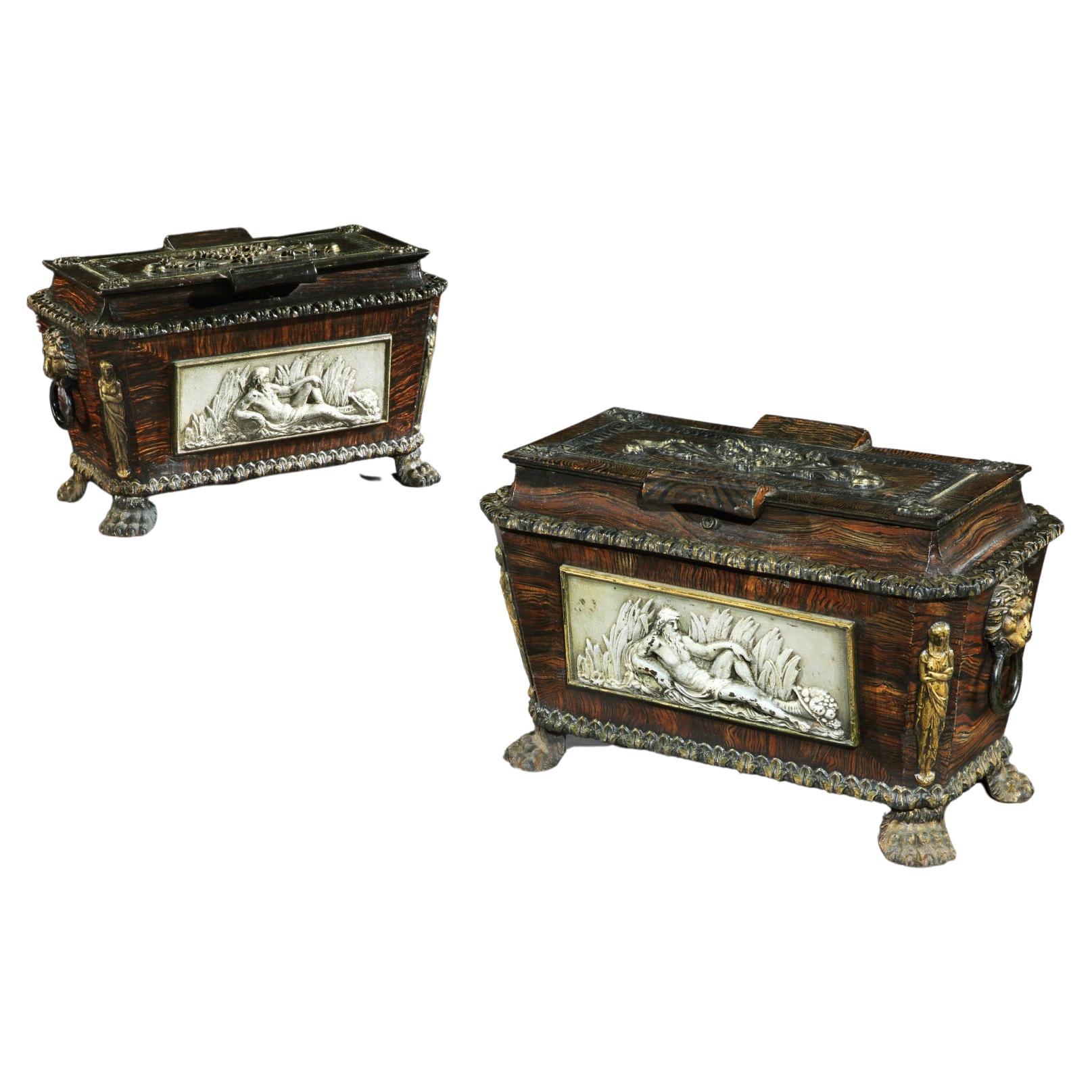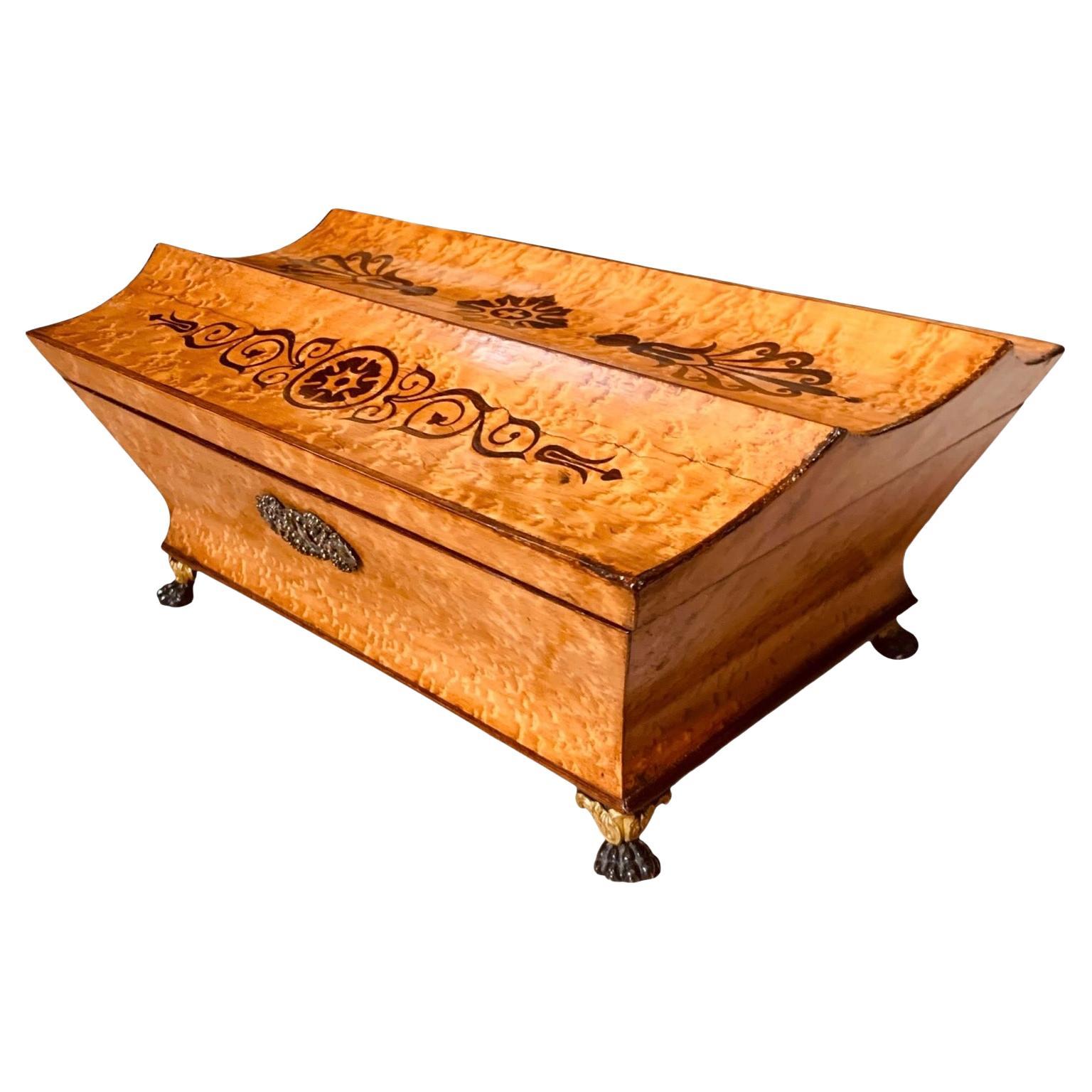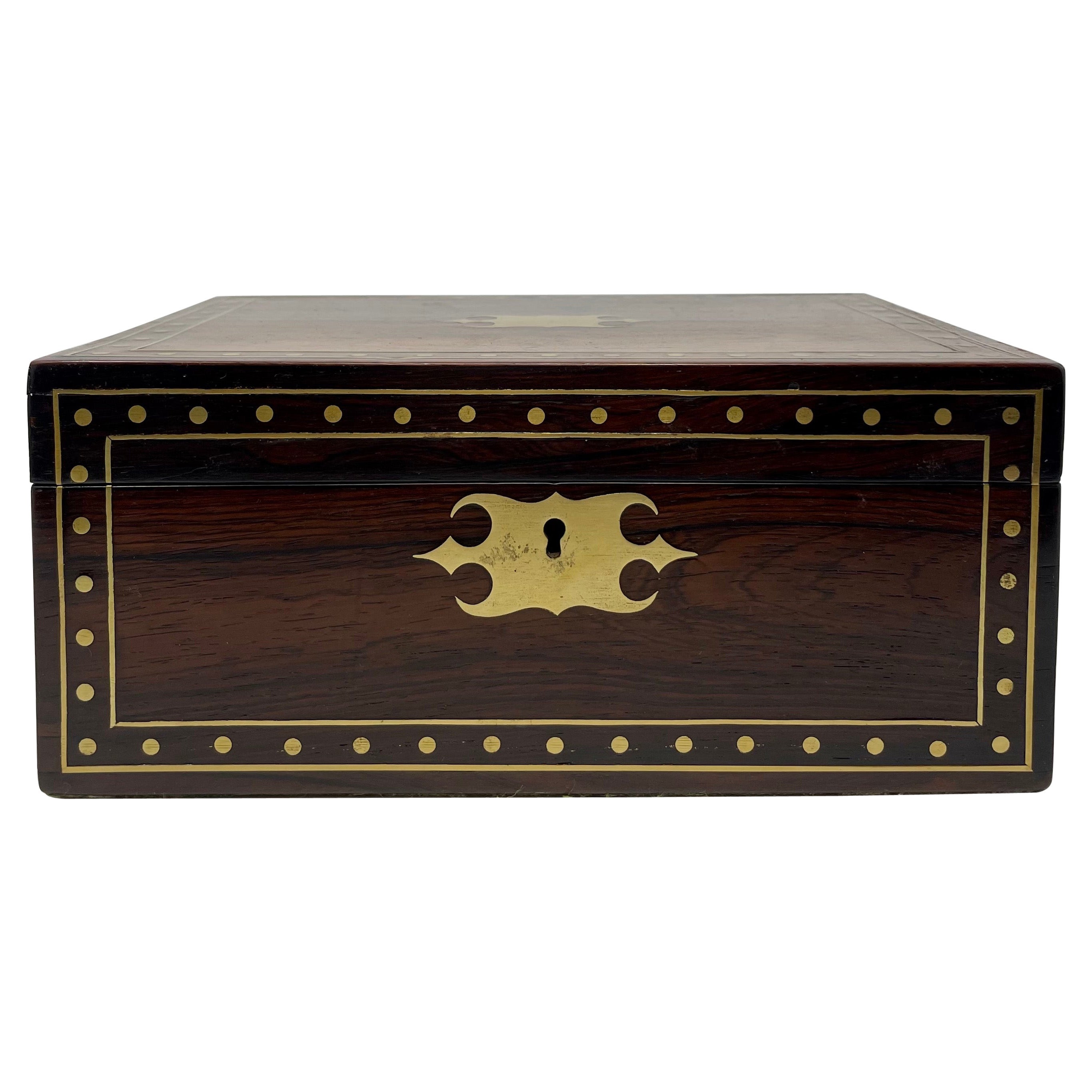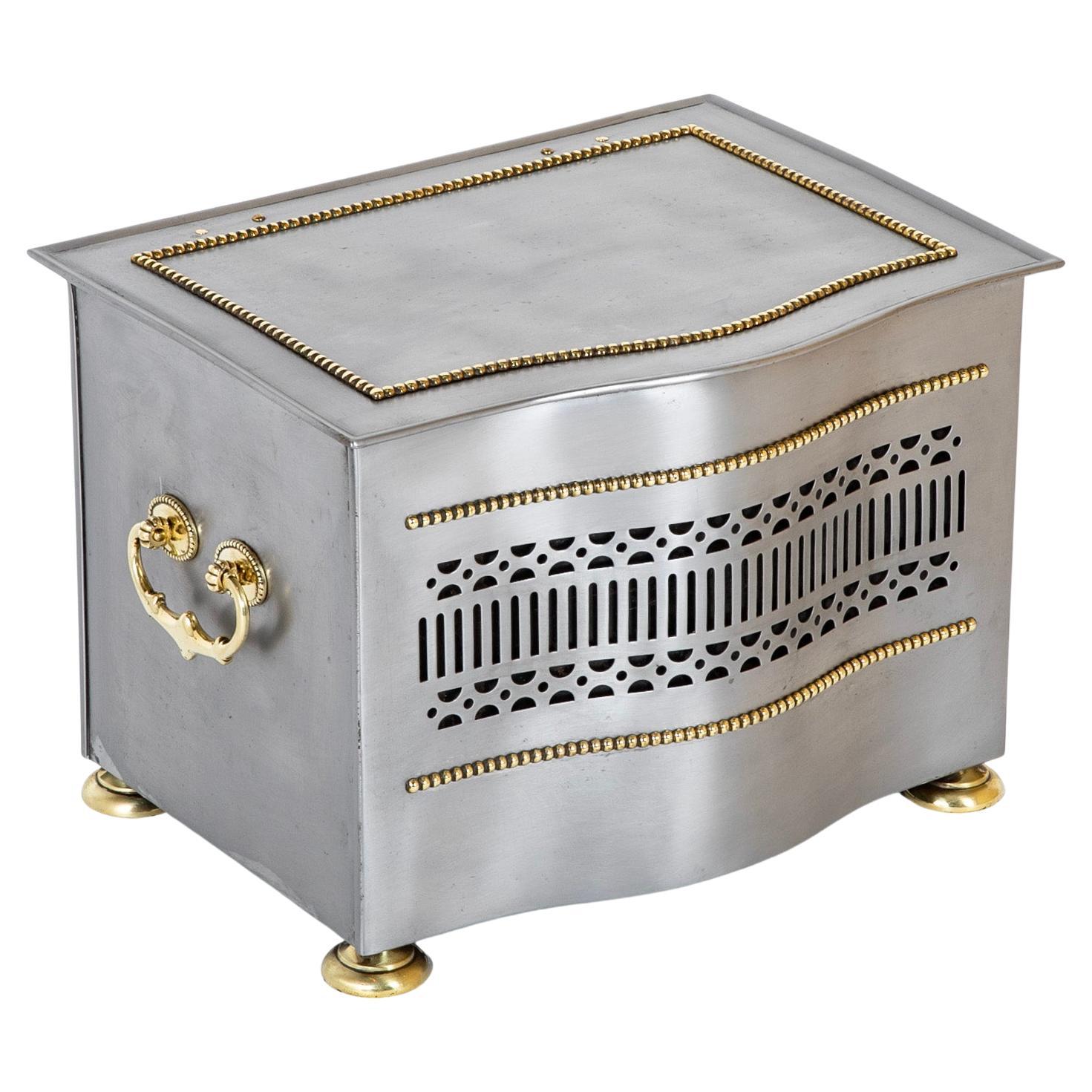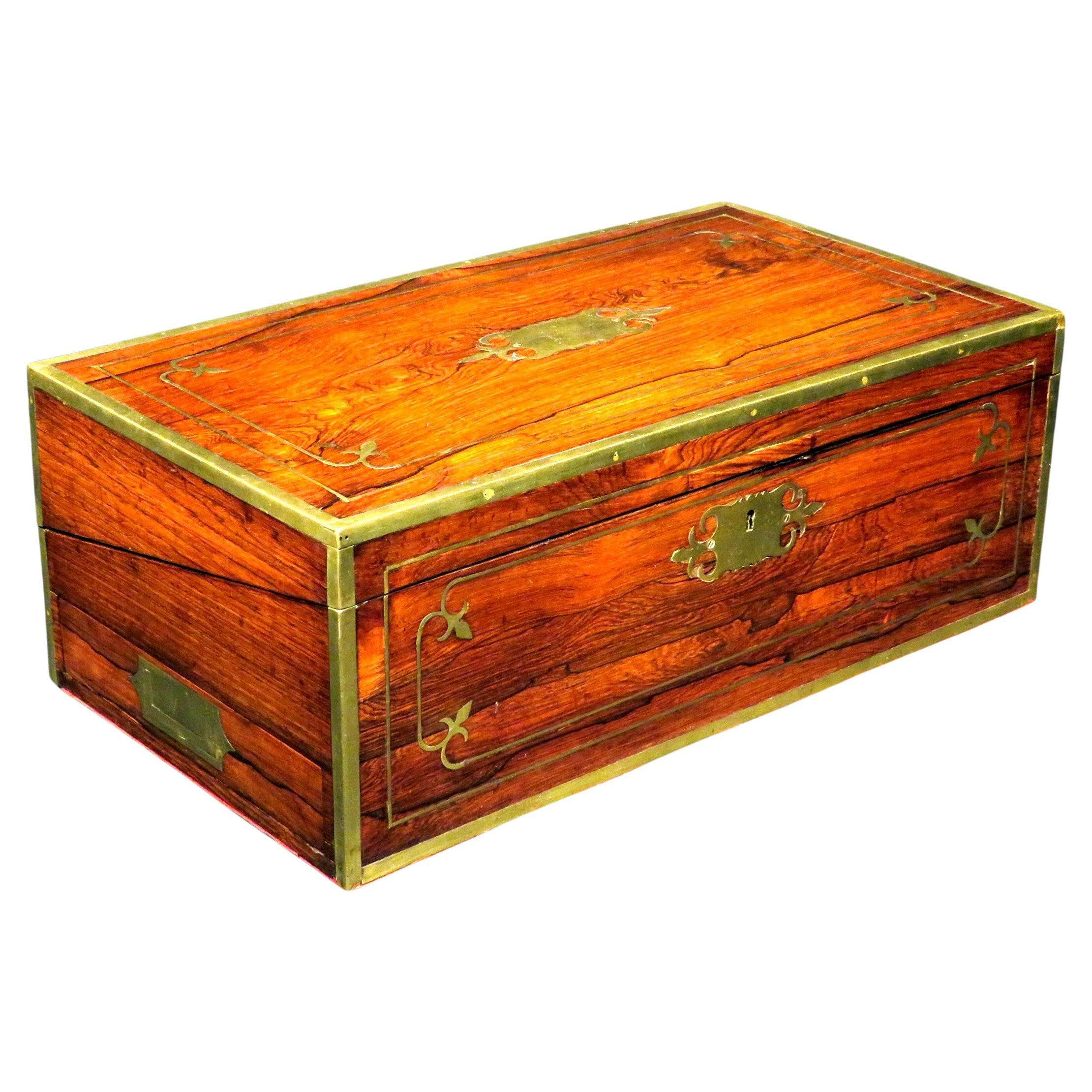Items Similar to Regency Period Steel Strong Box
Want more images or videos?
Request additional images or videos from the seller
1 of 19
Regency Period Steel Strong Box
About the Item
Our late Regency period strongbox features gilt neoclassical mounts including lion masks and rosettes at the sides, Roman Tuscan style columns at the front corners, figurative panel on front depicting Roman goddesses stoking a torchere, recumbent lion on the lid, lion paw feet, and interior with red painted finish with finely painted organic motifs in yellow and teal.
- Dimensions:Height: 14 in (35.56 cm)Width: 14.5 in (36.83 cm)Depth: 11.25 in (28.58 cm)
- Style:Regency (Of the Period)
- Materials and Techniques:
- Place of Origin:
- Period:
- Date of Manufacture:circa 1820s
- Condition:Wear consistent with age and use. Minor losses. No key. Rubbing wear to the gilding and partial loss to the mount on the left side. One of the feet appears to have been replaced and is loose on the front right side. Bronze foot at left front drilled for mounting to tabletop or floor.
- Seller Location:New York, US
- Reference Number:
About the Seller
No Reviews Yet
Vetted Seller
These experienced sellers undergo a comprehensive evaluation by our team of in-house experts.
Established in 1990
1stDibs seller since 2021
Typical response time: 1 to 2 days
- ShippingRetrieving quote...Ships From: New York, US
- Return PolicyA return for this item may be initiated within 2 days of delivery.
More From This SellerView All
- Renaissance Damascened Steel Casket from 1872 Great London ExhibitionLocated in New York, USOur gold damascened Renaissance Revival jewelry chest by Antonio Cortelazzo (1819-1903) was commissioned by the English lawyer and antiquarian, Sir William Drake (1817-1890) and exhibited by the artist at the 1872 International Exhibition in London. It features a pair of dragons supporting the arms of Drake plus repoussé trophies and gold-ground scrollwork, raised on scroll and mask feet. The lid is signed CORTELAZZO VICENZA FECIT 1870. With original descriptions written in ink on paper. The first reads "Steel Casket damascened gold and ornamented with 4 plaques of repousse work by Cortelazzo of Vincenza. Coll: Sir W R Drake S.L.A." where the initials refer to the Society of Antiquaries of London. The second similarly reads "Casket of Steel damascened with gold and ornamented with four plaques of silver repousse work. By Cortelazzo of Vincenza. Lent by Sir William Drake." Exhibition: International Exhibition of 1872, London. Provenance: The Collection of Sir William Drake, F.S.A., Christie's, London, June 30, 1891, lot 602, 33 GBP. The Collection of M.F. Adie Esq., purchased circa 1950 from H.W. Keil Ltd, Broadway, Worcestershire, England. Literature: The Official Catalogue, Fine Arts Department London, International Exhibition of 1872, London, J.M. Johnson & Sons, Victoria and Albert Museum. (See images here in our listing.) The Art Journal, London, 1872, p 2. Nineteenth Century Silver, J. Culme, London, 1977, p 17. The Layards, Cortelazzo and Castellani: New Information from the Diaries of Lady Layard, Jewellery Studies I, J. Rudoe, 1983, p 86. A Renaissance-Revival Masterpiece by Antonio Cortelazzo, B. Shifman, Cleveland Studies in the History of Art, vol 8, p 103. In 1872 The Art Journal Catalogue wrote "Among the art gems of the present exhibition are to be found the productions from the hand of Antonio Cortelazzo of Vicenza, now as well known in England for his skill as a metalworker as he is appreciated among his fellow workers in his native italy by whom he is recognized as Facile Princeps in the art. In the mechanical skill with which he inlays metal upon metal he has his rivals; but in the combination of that process with purity of design and artistic fancy of ornament which distinguishes all his works, he stands unrivalled. The 'Coffre' is in intarsia of gold and silver (partly flat and in other parts relief) on steel. It is one of numerous specimens of Cortelazzo's work which are to be found in the collection of Sir William Drake, one of the principal English patrons of the artist whose genius is now fully appreciated. Drake was a wealthy lawyer and collector of contemporary as well as renaissance and baroque works of art. A client of the connoisseur and dealer William Blundell Spence, Sir William acquired works by leading artists of the period including the Florentine sculptor and wood carver, Luigi Frullini (1839-1897), English art potters, the Martin brothers, and the celebrated goldsmith and damascener, Placido Zuloaga...Category
Antique Late 19th Century Italian Renaissance Revival Jewelry Boxes
MaterialsSteel
- Mosque Form Cellaret Wine Box in Fruitwood and BrassLocated in New York, USOur charming and rare cellaret in the form of a mosque is crafted from fruitwood and brass. It has a center dome and four smaller domes each decorated with brass crescent moons, each removeable to reveal compartments below to accommodate up to five bottles. The mosque form of the box makes it very unusual and rare for a wine casket.Category
Antique Late 19th Century Unknown Decorative Boxes
MaterialsBrass
- Antique Russian Neoclassical Gold and Agate Snuff Box Circa 1820sLocated in New York, USOur wonderful snuff box features a finely carved agate relief depicting Bacchus and Cupid, scrolling foliate motifs and roundels against a matte ground, and cover with blue enamel bo...Category
Early 20th Century Russian Neoclassical Revival Snuff Boxes and Tobacco ...
MaterialsGold
- Gold Snuff Box with Portrait of Napoleon by Jean-Baptiste Isabey '1767–1855'Located in New York, USOur gold snuff box is distinguished by its exceptional portrait of Emperor Napoleon I (1769-1821) by the revered miniature painter, Jean-Baptiste Isabey (1767–1855), signed and dated 1807. Isabey portrays the emperor in the green uniform of the chasseurs a cheval with red sash and silver breast-star of the Imperial French Order of the Legion of Honour. Pinned to his left lapel are the badges of the Imperial French Order of the Legion of Honour and the badge of the Royal Italian Order of the Iron Crown of Lombardy. The portrait is bordered by blue enamel and an outer border of rosettes and leaves. 3 1/2 by 2 1/2 by 5/8 inches. Weight: 135 g, 4.76 oz, 4.34 troy oz. Hallmarks on the underside of this German-made box include an assay mark, a lion rampant and maker's mark which is heavily worn. Born in Nancy, France, Isabey arrived in Paris in 1785 to study with Jacques-Louis David. His earliest clients included the family of Eugène Rose de Beauharnais...Category
Antique Early 19th Century French Empire Snuff Boxes and Tobacco Boxes
MaterialsGold, Enamel
- Italian Venetian Gondola Shaped Ceremonial CasketLocated in New York, USOur rare, 18th century ceremonial casket in the form of a Venetian gondola is expertly carved from walnut with gilt cartouches depicting figures and s...Category
Antique 18th Century Italian Decorative Boxes
MaterialsWalnut
- Russian Empire Period Birch Center TableLocated in New York, USOur Russian Empire period oval table with birch veneer with silver gilt eagle-mounted legs and paw feet measures 35 by 49.5 inches and 30 inches ...Category
Antique Early 19th Century Russian Empire Furniture
MaterialsBirch
You May Also Like
- Extremely Rare Pair of Regency Cast-Iron Sarcophagus Shaped Strong BoxesLocated in Benington, HertsAn extremely rare pair of Regency cast-iron sarcophagus shaped strong boxes. Regency, circa 1820 Painted to simulate palisander wood and with parcel-gilt, the cavetto-moulded hinged lids cast with flower sprays above foliate-cast bands over front panels relieved with river gods within canted corners cast with standing muses, the sides with lion mask and ring handles over leafy aprons on massive lion’s paw feet; the Brahmah type lock stamped “T. Davis from London” and impressed with the Royal Crown. These extraordinary pieces are modelled on Regency wine coolers. The forms are classic Greco-Roman revival with the boat-hook handles, mythic figures and the overall sarcophagus pattern. You would struggle to find one let alone a pair. Good items for any collection. Research on going into these strong boxes but we have found possible information on the lock stamped Davis….(historyoflocks ) The relationship of King George III and George Davis of Windsor, who was locksmith in ordinary to His Majesty. Davis, in 1799, invented and patented a unique style of lock, which was also beautifully engraved with a warning not to make duplicate keys. Sensitive government secrets always demanded, then as today, locks that were state of the art. Davis locks ended up on government dispatch boxes...Category
Antique Early 19th Century English Regency Commodes and Chests of Drawers
MaterialsIron
- Fine English Regency Period Bird’s Eye Maple Marquetry BoxLocated in Free Union, VAA very fine and exquisitely grained bird’s eye maple box of unusual form: the top curved into three concave channels, each one inlaid with contrast...Category
Antique Early 18th Century English Regency Decorative Boxes
MaterialsBirdseye Maple
- Antique English Regency Period Rosewood Inlaid Box, Circa 1820.Located in New Orleans, LAAntique English Regency Period Rosewood Inlaid Box, Circa 1820.Category
Antique Early 19th Century English Regency Decorative Boxes
MaterialsRosewood
- Regency Style Brushed Steel and Brass Tinder BoxLocated in Stamford, CTUnusual and very handsome brushed steel and polished brass tinder box. This box has a removable tin liner that would have been used to fill with hot c...Category
Early 20th Century English Regency Decorative Boxes
MaterialsBrass, Steel
- Early 19th Century Regency Period Flame Mahogany Tea Caddy BoxLocated in High Wycombe, GBRegency period early 19th century flame mahogany tea caddy box with swing handle complete with an original hallmarked sterling silver George III tea caddy spoon Comes with working key, item opens to reveal a fitted interior with twin caddies & central crystal mixing bowl which is a later addition. A tea caddy is a box, jar, canister, or other receptacle used to store tea. When first introduced to Europe from Asia, tea was extremely expensive, and kept under lock and key. The containers used were often expensive and decorative, to fit in with the rest of a drawing-room or other reception room. Hot water was carried up from the kitchen, and the tea made by the mistress of the house, or under her supervision. As the use of the jar waned and the box became more popular, the provision of different receptacles for green and black tea...Category
Antique 19th Century British Regency Tea Caddies
MaterialsSterling Silver, Brass
- Regency Period Brass Bound Rosewood Campaign Writing Box, England, Circa 1815Located in Ottawa, OntarioA superior Regency period brass bound writing box constructed of richly figured Brazilian rosewood, the hinged top inset with a blank brass cartouche and opening to an interior fitted for inkwells & writing implements, including two replace gilt-tooled leather writing panels that cover document compartments, one housing three concealed spring activated ’secret’’ drawers. The interior also featuring a hinged arm that elevates to support the top when being used as a reading lectern...Category
Antique Early 19th Century English Regency Decorative Boxes
MaterialsBrass
Recently Viewed
View AllMore Ways To Browse
Late Regency
Regency Period Furniture
Regency Period
Organic Motif
Roman Period
Painted Box Red
Gilt Steel
Regency Lions
Lion Regency
Late Regency Period Furniture
Roman Period Style
Antique Teal Furniture
Tuscan Style
Antique Red Paint Finish
Lion Lid
Antique Strong Box Antiques
Antique Strong Box
Antique Strong Boxes
